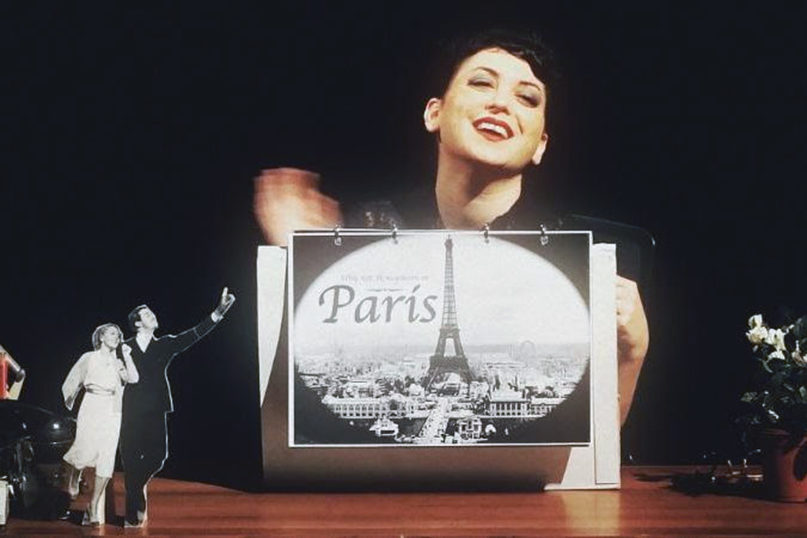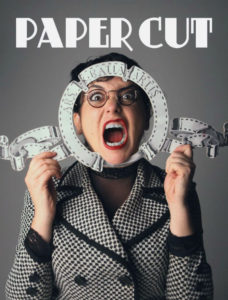
Israeli puppeteer Yael Rasooly brings her object theater to Trinity College
By Stacey Dresner
HARTFORD – Punch and Judy, step aside.
Yael Rasooly is here. And with her, the acclaimed Israeli puppeteer brings a startling brand of visual theater that is, to say the least, nontraditional.
Rasooly arrived recently in Hartford, where she is teaching her craft at Trinity College for the spring 2019 semester. She comes to Trinity as part of the Israel Institute’s Visiting Artists Program. The program is funded by the Schusterman Family Foundation, which brings Israeli artists from film, music, choreography, and the visual arts to North America for residencies. Besides teaching classes, the artists connect with their communities through lectures, exhibitions, screenings, readings, and performances.
While here, Rasooly will also teach a puppetry class at the University of Connecticut, which is home to the renowned Ballard Institute of Puppetry, and at the Eugene O’Neill Theater Center in Waterford.
Rasooly’s performance pieces – which include music, dance, with particular attention paid to lighting and sound – create theater that is funny, original and magical. It is often called “puppetry for adults.”
“When people discover this genre, there is no going back – they just can’t get enough of it,” says Rasooly.
 To understand Rasooly’s brand of puppetry one need only to experience her performances, including her one-woman show, “Paper Cut.” Created in 2010, in “Paper Cut” Rasooly uses objects, such as paper and cardboard cutouts of old-time movie stars, as she plays a secretary who escapes into her own fantasy world sitting at her desk late at night.
To understand Rasooly’s brand of puppetry one need only to experience her performances, including her one-woman show, “Paper Cut.” Created in 2010, in “Paper Cut” Rasooly uses objects, such as paper and cardboard cutouts of old-time movie stars, as she plays a secretary who escapes into her own fantasy world sitting at her desk late at night.
Her semester teaching at Trinity is a first for Rasooly – and one she eagerly approaches.
“I’ve been teaching quite a few years. I usually teach workshops for a couple of days or a couple of weeks but I never have had this kind of long process with the students,” she says. “My class is for contemporary puppetry and object theater. Every student is a performer and a director, and the course aims to encourage independent creation. Also there is physical and vocal training. It’s mostly practical but I will also be introducing them to leading Israeli and European puppeteers.”
In the first week of classes, she has also had to instruct her students on what exactly this “puppetry for adults” is all about. To introduce her craft, she performed “Paper Cut” for her students at Trinity.
“I create something that doesn’t like definitions. People like putting things in boxes. One of my students said to me just this week, ‘I came to your show hearing it was adult puppetry, and I didn’t know what to expect and I wasn’t so optimistic because puppetry is for children,’” Rasooly laughs. “And then he said, ‘I couldn’t believe it, it was nothing like I ever thought or expected. I didn’t know you could do things like this.’
“And I think that is exactly it,” Rasooly explains. “It’s like you are inventing a language; you are inventing a visual language. Visual theater, puppetry, object theater – whatever you want to call it – really includes a lot of personal expression but also is an immediate and very powerful art form.”
Art has always been a large part of Rasooly’s life.
Born in Jerusalem to two physicians who were also lovers of the arts, Rasooly and her siblings were encouraged to study music.
“I started very early in the arts. I started playing the piano when I was four and I started singing when I was seven. I was classically trained,” she says.
Rasooly lived in Toronto from age six to 10. When she returned to Israel she began touring with a girl’s chorus.
“My first tour was performing with the Berlin Philharmonic,” she says.
But the constant classical training sessions, auditions and touring at such a young age caused a lot of stress.
“I think a lot of what brought me to change the direction of my art, and the discipline I’m in now is a reaction to the things I did not want to keep having around me – the competition and the constant comparisons,” she said. “I didn’t want to be just an opera singer and I had had enough of people making art, which is something vital to me, into something that is so competitive and stressful.”
After high school she studied theater design in London. One day, by chance, she saw an adult puppetry show in London and was fascinated.
“It was three guys doing show with objects and toys. Bizarre stuff, but so good, so well manipulated, so cinematic. It was just like David Lynch and a bit Hitchcock. I was so impressed. I said, ‘Oh my God, what is this?’ It really hit me.”
She contacted Penny Francis, a British puppetry performer and promoter who said, “Welcome to the world of adult puppetry!” She gave Rasooly a list of things she needed to do to enter the field.
The first thing on the list was to go to the Charleville Mézierès Festival in France, “the Mecca of Puppetry,” as Rasooly calls it. Held biennially, the 10-day Festival features 250 troupes performing in theaters, in fields and in the streets with puppets, marionettes and objects
Rasooly stayed for the entire Festival, watching dozens of shows. She was hooked.
She went back to Israel and was eventually accepted into the School of Visual Theatre in Jerusalem, where she specialized in directing, puppetry, and design, and also studied movement, singing, drama, puppetry and more.
It was at the school that she created her first piece, “How Lovely,” which she performed at festivals in Holland, France and Poland.
After finishing school she moved to Tel Aviv, where she lived with other artists and tried to find funding for her performances.
She created her piece “Paper Cut” in 2010, with co-writer and designer Lio Lerman. It tells the story of Ruth Spencer, a secretary in the 1950s who is in love with her boss. When everyone else in the office goes home at night, she stays to work on a pile of papers her boss drops on her desk.
“I think a part of me really wanted to do something humorous. It has many levels. I’ve always been in love with cinema. I wanted to give an audience the feeling I had watching a Hitchcock film as a teenager, and all the experience you have in general when you watch a film that really grips you.”
She had collected many books with cinematic photos already, and she began working with the paper “manipulating these images.”
“We really thought about the language of cinema, translated low-tech, with two-dimensional objects and some pop-ups. And it worked. That pile of papers becomes her escape from reality to another realm where they are in one of those romantic Hollywood films of the 30s,” she says.
Romantic music from films of the ‘30s plays and Ruth become a veritable whirlwind, acting out scenes with her paper cutouts of Gary Grant and Greta Garbo, as she lip synchs dialogue from the classic films “Gaslight” and “Rebecca.”
“Paper Cut” has now been performed more than 400 times in more than 30 countries, including last month at the International Puppet Festival in Chicago.
The granddaughter of a Holocaust survivor, the Shoah also plays a theme in much of her work.
Her piece “The House on the Lake” came about after Rasooly befriended a resident of a nursing home neighboring her house in Jerusalem.
“Alice was a Holocaust survivor from Holland and she hid in 10 or 11 places during the war. She would tell me her experiences about hiding and then the next day she would be giving me dating tips. We laughed a lot and cried a lot.”
Rasooly went on to meet several survivors who had hidden as children. Then, after seeing an exhibit at Yad Vashem about dolls and toys that had belonged to children who were in hiding during the war, Rasooly was inspired to create “The House on the Lake.”
Co-written by Yaara Goldring, the piece focuses on three little sisters going about their days while in hiding, waiting for their mother to return, and practicing their music lessons as their mother told them to do.
“The speech is very minimal. The stage is a bare wooden floor with a door, three chairs and three dolls that are the copies of [the three sisters]. As time passes and winter is getting near and there is no food, the fantasies grow stronger,” Rasooly explained.
The story is told in two different times, the past with the three little girls, and the present, as the sister who survives, now a cabaret singer, tells the story of her and her sisters hiding from the Nazis.
“It is heartbreaking, but at the same time we really wanted to take people into that journey with all the colors that were there – we wanted to do it in a very poetic and visual way. There is also a lot of humor in the show. It’s been a very big adventure with this show and a powerful experience.”
Rasooly hopes to perform the show in a festival in Bialystok, Poland this year. It has also been staged in France, Denmark and Canada.
When she is not performing in one of her puppet shows, Rasooly still sings, cabaret-style. But her beloved object theater, she says, is an important medium she feels blessed to have found.
“There is a very strong need for this, as we are all glued to our phones, our screens,” she says. “We need that magic of just being in that theater space and just letting go of reality. Letting yourself be swept away whether it is tragic or hilarious. I feel very fortunate that I get to do this.”
CAP: Israeli puppeteer Yael Rasooly performing her one-woman show “Paper Cut.”







 Southern New England Jewish Ledger
Southern New England Jewish Ledger













